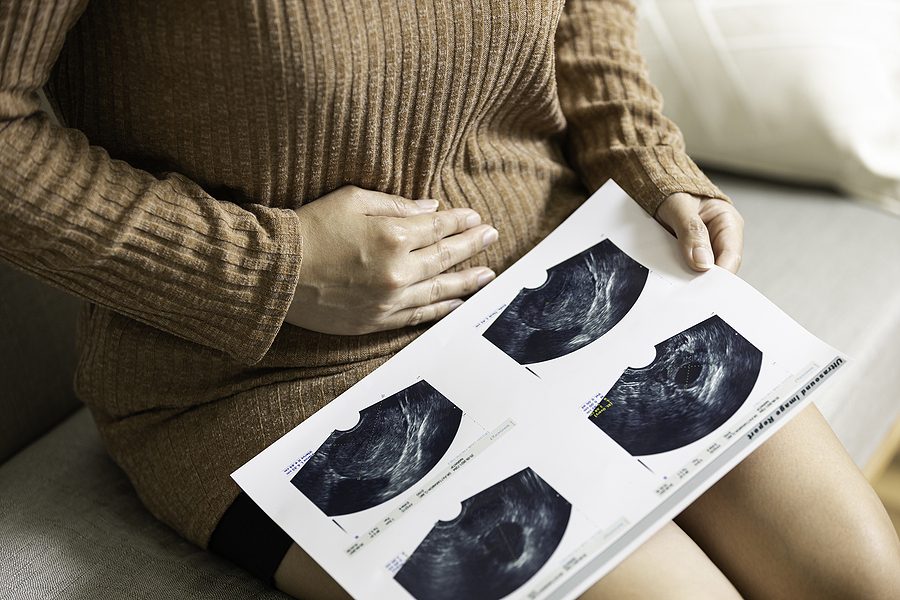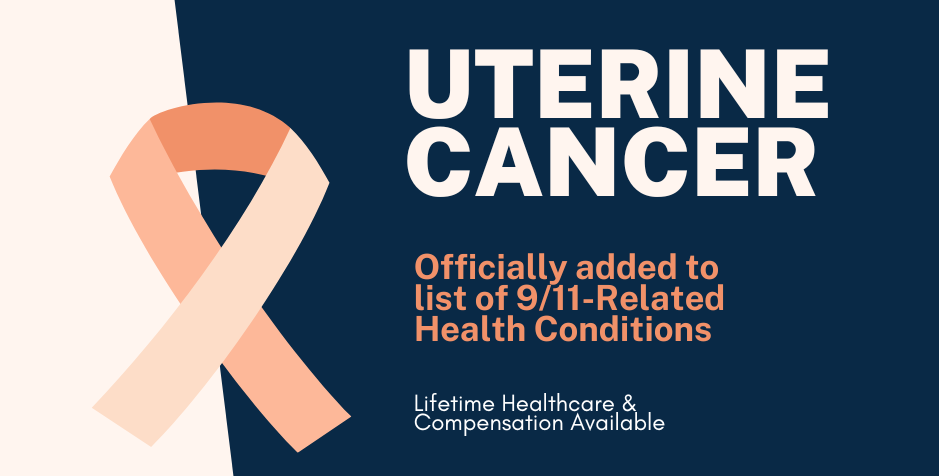Lawmakers Urge Health Program to Decide on Uterine Cancer Coverage

New Jersey Representative Mike Sherrill recently led a group of bipartisan congress members to draft a letter that was sent to the program administrator for the World Trade Center Health Program, urging him to hurry up and decide whether uterine cancer will be included in the list of covered conditions for the program. The letter followed the release of new scientific evidence that the chemicals present in the World Trade Center dust plume are commonly linked to the disease.
The letter from the members of Congress also reminded the program administrator that other cancers already on the list of covered conditions affect the female and male reproductive systems, such as cancers of the vulva, vagina, cervix, uterus, prostate, penis, and testes.
The 9/11 benefits attorneys from Hanson & Rosasco have reviewed the information provided regarding the link between 9/11 toxic exposure and uterine cancer and wholeheartedly support the inclusion of this form of cancer on the list of conditions eligible for certification through the WTC Health Program. Read on for more information.
The 9/11 Connection to Uterine Cancer
A team of scientists and physicians from Rutgers’ Environmental and Occupational Health Sciences Institute and the WTC Health Program’s Center of Excellence led a petition drive to add uterine cancer to the list of covered conditions. The team cited evidence that endocrine-disrupting chemicals (EDCs) were found in the toxic dust plume in the 9/11 exposure area on September 11, 2001, and in the months that followed—chemicals known to cause a type of uterine cancer known as endometrial cancer.
The CDC director’s letter reminded the program administrator that many women worked on the front lines during the 9/11 terrorist attacks, and more helped in the rescue, recovery, and cleanup operations in the following months. Additionally, women lived, worked, or attended school in the New York City disaster zone that toxic dust from the 9/11 attack enveloped in the months that followed.
Why It Matters
The list of covered conditions is a tool to determine if a 9/11 responder or survivor may obtain medical treatment and monitoring benefits from the federal WTC Health Program. In addition, those who wish to seek compensation through the September 11th Victim Compensation Fund (VCF) are generally considered eligible to file a claim through certification by the WTC Health Program of a covered condition.
The VCF began compensating victims of 9/11 and their families shortly after the terrorist attacks occurred. This initial version of the VCF ran until 2004, before being shuttered until 2011, when the James Zadroga 9/11 Health and Compensation Act reauthorized the fund.
The same act also created the WTC Health Program and provided the mechanism involved in certifying a condition for the program as the determining factor for eligibility to obtain compensation for the expenses and impacts of the diagnosed condition as well.
About Endometrial Uterine Cancer
Endometrial cancer is a type of cancer that forms in the lining of the uterus, which is known as the endometrium. This is the most commonly diagnosed uterine cancer. It presents with:
- Vaginal bleeding after menopause
- Break-through bleeding between periods
- Pain in the pelvic area
How Doctors Diagnose Uterine Cancer
Uterine cancer is generally diagnosed using:
- A pelvic exam in which the physician carefully examines the outer portion of the genitals, in addition to digitally examining the uterus with the fingers. A speculum may also be inserted into the vagina to open it so the doctor can examine it for visual signs of cancer, such as tumors.
- A transvaginal ultrasound, which uses sound waves to examine the uterus for the abnormal thickness of the endometrium.
- A hysteroscopy, which is a procedure in which a thin, lighted scope is inserted into the vagina and through the cervix to examine the endometrium.
- A biopsy, which involves aspirating a tissue sample with a hollow needle from the affected area to collect cells that can then be analyzed in the laboratory to determine if they are abnormal.
- Dilation and Curettage (D&C), which is a procedure used when the biopsy fails to yield clear results to scrape the lining from the uterus so it can be examined under a microscope.
Common Treatments for Uterine Cancer
There are several treatment options for uterine cancer, with the appropriate option for a specific patient depending on how far the disease has spread, as well as other considerations such as how physically able the patient is to handle a specific course of treatment.
Treatment options include:
- Surgery to remove the uterus, which is known as a hysterectomy. Sometimes, the ovaries and fallopian tubes will also be surgically removed, usually if cancer has spread to those organs from the uterus.
- Radiation therapy, which uses high-powered energy beams such as X-rays and protons to target and kill cancerous cells. Radiation can involve aiming these beams at the affected region of the body from an outside machine, or the insertion of radioactive seeds or some other type of radiation-delivery device into the body.
- Chemotherapy, which involves the use of chemicals that are delivered in pill form or intravenously and travel through the body, killing cancer cells.
- Hormone therapy, which uses medication to reduce the body’s hormones, thus reducing the cancer cells, as they rely on these hormones to survive. Hormone therapy is most often used in cases in which the disease has spread beyond the uterus, and other traditional treatment methods are not appropriate for the patient.
- Targeted drug therapy, which involves the patient taking a drug formulated to target cancer cells. This treatment option is often provided in addition to chemotherapy for maximum results in destroying active cancer cells.
- Immunotherapy, which is a type of drug that is designed to make the immune system of the recipient stronger, enabling it to more effectively fight the cancer on its own by interfering with the cancer cells’ process of blinding themselves to the body’s immune system by producing proteins. This treatment option is often used in advanced cases in which other treatments are not safe for the patient.
- Palliative care, which involves the treatment of pain produced by a serious illness and is often provided in addition to some of the more aggressive treatments for uterine cancer, such as surgery, chemo, or radiation.
Prognosis
Endometrial cancer, when diagnosed in the early stages and promptly treated, poses a 5-year survival rate of 95 percent. However, the longer it takes for a diagnosis after cancer cells appear and begin to grow, the grimmer the prognosis is.
The 5-year survival rate for uterine cancer that has spread to distant regions of the body is 17 percent. It is important to remember that, while the stage of cancer at diagnosis is an important factor in the prognosis of the patient, other factors will also affect the survivability of the disease, including the sufferer’s age and other present medical conditions.
About the WTC Health Program
Along with the reauthorization of the VCF, the Zadroga Act created the WTC Health Program. This program is available for responders and survivors who were present in the WTC disaster zone from September 11, 2001, to July 31, 2002, or one of the other 9/11 attack sites who were present at the site for a minimum amount of time. The program pays for all medically necessary treatments for the covered condition, as long as the treatment is provided by a WTC Health Program-affiliated medical center or pharmacy.
Care is generally provided through one of the programs Centers of Excellence medical facilities located throughout the New York City region. Because the responders and survivors of 9/11 are living in every state in the nation, there is also a network of health care providers working outside of the region where the attack took place who can provide care in the home states of distant members.
What Are Certified Conditions?
When an individual seeks a medical evaluation from the WTC Health Program, the providers of this evaluation will look for covered conditions. There are currently many conditions that result in certification and eligibility to participate in the federal 9/11 benefits program, with new conditions being added periodically when there is compelling evidence that exposure to 9/11 toxins is a likely cause of the condition.
What Impact Would the Inclusion of Uterine Cancer Have on Survivors and Their Families?
The inclusion of uterine cancer on the WTC Health Program’s list of covered conditions would allow the benefits provided by the VCF and the WTC Health Program to become available for more survivors and responders of the attacks.
By being eligible to participate in these programs as a result of the covered condition, more women will have access to medical treatment and monitoring that could provide an early diagnosis, which greatly influences the ability of the sufferer to survive the disease.
Having uterine cancer added to the list of certified conditions also helps the sufferer and/or her family members to obtain compensation for wage loss and pain and suffering associated with uterine cancer.
Seeking Benefits Following the Diagnosis of a 9/11-Associated Illness
The WTC Health Program’s benefits are accessed through an application process in which the applicant submits information about the type of exposure they experienced on or around 9/11, as well as the amount of time they spent at one of the 9/11 attack sites.
Once the applicant applies and provides supporting documentation, the WTCHP will review these items. A program-affiliated provider trained to look for symptoms of the conditions associated with 9/11 toxic exposure then evaluates eligible applicants
After a diagnosis, the program certifies the condition and provides health care treatment and monitoring to the applicant. The applicant can then register on the VCF website.
Registration is not the same as filing a claim. It only reserves your right to do so any time before October 2090. You must register within two years of the date on which the condition was certified. For family members seeking compensation following the death of a loved one that was caused by a 9/11-associated condition, registration to file a claim must be completed within two years of the date of the survivor or responder’s death.
It should be noted that there are a few other federal and state options for seeking compensation and other benefits for your 9/11-related illness, including Social Security Disability Insurance (SSDI). The attorneys at Hansen & Rosasco can look at the details of your case to help you determine if you are eligible for these other programs.
An Attorney Can Help You With Your WTC Health Program Application
9/11 benefits lawyers are dedicated to helping 9/11 survivors, responders, and their family members to claim benefits for exposure to the toxins at the terrorist attack sites. They can help you apply to the WTC Health Program so it can certify your condition and assist in filing a VCF claim.
They also can appeal denials by either program and assist you with applying for other needed assistance.
The emotional and physical trauma created by the terrorist attacks that occurred on 9/11 is far from over. Let an attorney help you get the help you need to fight your 9/11-related illness.




